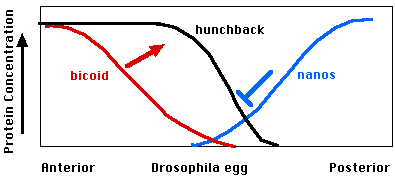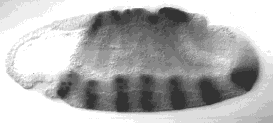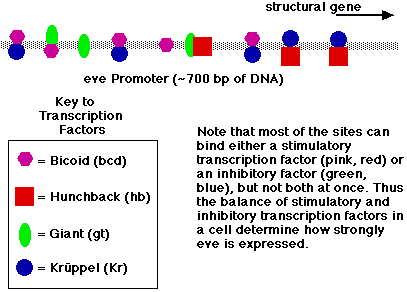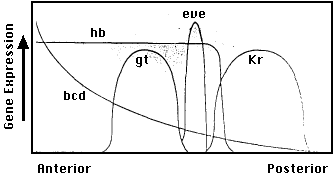Organizing the Embryo: Segmentation
Insects, like all arthropods, are segmented. The body of Drosophila melanogaster is built from 14 segments:
- 3 segments make up the head with its antennae and mouth parts.
- 3 segments make up the thorax. Each thoracic segment has a pair of legs (insects are the six-legged creatures). In Drosophila (and other flies), the middle thoracic segment carries a single pair of wings; the hind segment a pair of halteres.
- 8 abdominal segments.
What signals guide segment formation?
The process begins with the gradients of messenger RNA (mRNA) that the mother deposited in her egg before it was fertilized.

Shortly after fertilization, these are translated into their proteins with
- a gradient of bicoid diminishing from anterior to posterior and
- a gradient of nanos diminishing from posterior to anterior.
- Bicoid protein is a transcription factor. It binds to the promoter of a gene called hunchback (hb), turning it ON (red arrow).
- Nanos protein binds to hunchback mRNAs, inhibiting their translation (blue bar).
- These effects combine to produce a high level of hunchback protein at the anterior of the embryo; with a sharp cut-off toward the posterior.
- The hunchback protein is also a transcription factor (as we shall see).

- These concentration gradients regulate the turning on and off of other genes in sharply-defined regions of the embryo.
- These establish the various segments of the body.
The gene even-skipped (eve) is expressed in 7 bands or stripes corresponding to 7 of Drosophila's 14 segments (skipping the even-numbered ones). The photo (courtesy of Peter A. Lawrence and Blackwell Scientific Publications) shows the 7 stripes of eve activation.

At first the gene is expressed in fairly broad zones, but in time its expression becomes restricted to ever-narrower stripes.
The mechanism by which this occurs is known for the second stripe.
The eve promoter has binding sites for the proteins encoded by
bicoid (bcd)
hunchback (hb)
giant (gt)
Krüppel (Kr)
- Binding of bicoid and hunchback proteins stimulates transcription of eve.
- Binding of giant and Krüppel represses transcription.
 |
- Trapped in a valley between high levels of the giant and Krüppel proteins, expression of eve in the second stripe finally becomes limited to a band of cells only one cell thick. (A different set of promoter sites is used in the third eve stripe so expression is not repressed there.)
In principle, then, such a system of interacting gradients of transcription factors could act as on-off switches, which in time partition the embryo into its future segments.
|
Drosophila development (and probably that of animals in general) passes through three rather different (although often overlapping) phases:
- establishing the main axes (dorsal-ventral; anterior-posterior; left-right). This is done by gradients of mRNAs and proteins encoded by the mother's genes and placed in the egg by her.
- establishing the main body parts such as the notochord and central nervous system in vertebrates.
and the segments in Drosophila (discussed here). These are run by genes of the zygote itself.
- filling in the details; that is, building the various organs of the animal. (Our example will include the wings, legs, and eyes of Drosophila.)
25 April 2014




